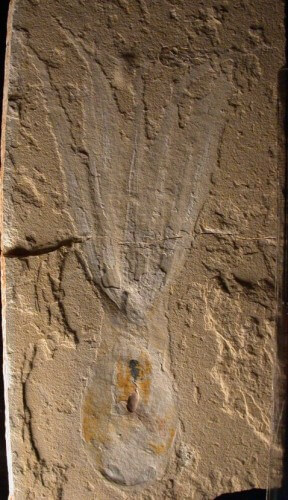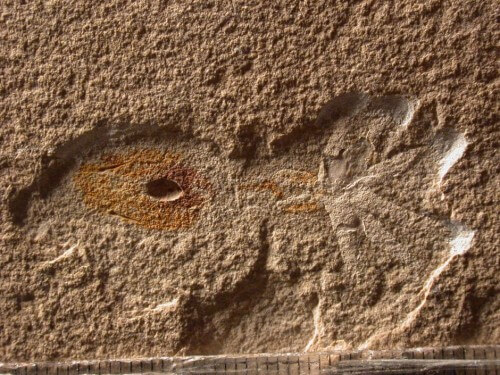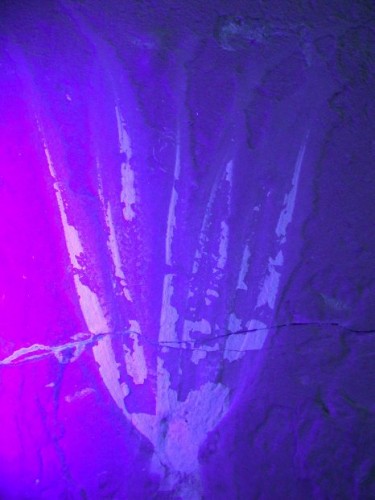Extremely rare fossils of ancient octopuses have been found in Lebanon
Noam Levithan and Yonat Ashhar Galileo

Fossils - the remains of ancient organisms - can only form under special conditions, which usually do not exist. One of the conditions that can help to create fossils is the presence of hard body parts, such as bones or shells, in the fortification of the appetizer as well as a maddening protection of the carcass and its decomposition. Even rarer fossils are fossils in which soft tissues have been preserved. Sometimes an organism without hard body parts leaves a pattern, an imprint, of its body in the rock, but very rarely the soft body tissues are preserved after being replaced by minerals. Fossils of this rare type were recently discovered by Dirk Fuchs from the Free University of Berlin and his colleagues, in limestone rocks in Lebanon, at a site located approximately 45 km from Beirut and 15 km from Jebel. The fossils are of three species of octopuses that lived about 95 million years ago. The finding was published in the scientific journal palaeontology.
Octopuses are mollusks and have almost no hard body parts. When an octopus dies, its soft tissues rot quickly and usually no trace of it remains. Thus, even though the octopus species are extremely diverse and there are more than 300 different species of them today, until now only a single fossilized ancient octopus species was known. Fortunately, when the octopuses found in Lebanon died, they quickly sank to the oxygen-poor seabed and were covered in sediment without rotting. Because of this, well-preserved fossils were obtained, whose soft tissues turned into a yellowish-white mineral apatite (calcium phosphate).

When you look at these fossils you can immediately notice how similar they are to contemporary octopuses: they have a sack-like body and head with eight arms attached to the front end (hence the name of the class to which octopuses and their relatives belong: cephalopods) and on the arms are rows of snap buttons. In the fossils it is also possible to distinguish remains of muscles, gills, the ink sac and even the ink itself that leaked out of the sac.
Although the shape of fossil octopuses resembles the octopuses we know today, not every eight-armed cephalopod is a modern octopus, just as not every four-legged, tailed mammal is a rhinoceros. Thanks to the excellent state of preservation of the octopuses that were discovered, it is possible to distinguish that they are indeed not contemporary octopuses, but rather represent a transitional form between the ancestor of octopuses and the common octopus species today.
One of the prominent features, different from the ancient octopuses, is the remains of the shell. Many molluscs have a shell, but it has degenerated in octopuses and their close relatives, squid. In the case of the squids, a sort of tiny plate remained from the shell inside their body, while in the octopuses the shell degenerated even more, until all that remained of it was a pair of tiny, rod-like internal structures. The disappearance of the shell is what enables the impressive and famous flexibility of modern octopuses.

The findings that the researchers discovered in these rare fossils, and the differences between the fossilized octopuses and their contemporaries, allowed the researchers to learn more details about the evolution of octopuses, about which so little is known. Their conclusion was that the inner shell of the ancestors of the octopuses was cut during evolution into a pair of calluses that moved away from each other, degenerated into a pair of rods and continued to degenerate until the structures present in modern octopuses. The discovery of the fossils also revealed that despite the fact that 95 million years ago there were octopuses with relatively large shell remains, octopuses that apparently were not the ancestors of the modern octopuses but represent an ancient state, there existed at the same time octopuses (such as the third species described) with structures reminiscent of modern octopuses , and apparently they were their ancient ancestors.
The original article:
Fuchs, D., Bracchi, G. & Weis, R. New octopods (Cephalopoda: Coleoidea) from the late Cretaceous (Upper Cenomanian) of Hâkel and Hâdjoula, Lebanon. palaeontology 52, 65-81 (2009). doi: 10.1111/j.1475-4983.2008.00828.x
The original article appears in the Galileo magazine issue 129, May 2009

7 תגובות
Oh, Michael stared. An imaginary number indeed. We corrected and addressed his mistakes here:
http://www.genetics.org/content/181/2/821.short
http://onlinelibrary.wiley.com/doi/10.1111/j.1550-7408.2009.00460.x/abstract
And I took my number from an article in Science that really measured mutations in humans, you can read about it and more here:
http://sandwalk.blogspot.co.il/2013/03/estimating-human-mutation-rate-direct.html
Regarding C - all creatures are a transitional form, including you. There is no such thing in evolution as a crocoduck that is a transition between reptiles and birds, it exists only in the minds of creationists. In the case of these extinct octopuses, they represent the transitional form from an octopus with a large inner shell to the octopus we know today.
Regarding D - I did not write that there is no change. I wrote that *you* are not able to see the change. According to the theory of evolution, creatures change all the time even if externally they remind you or their creation of some other existing creature. Just as they wrote in the entry here: "Not every cephalopod with eight arms is a modern octopus, just as not every mammal with four legs and a tail is a rhinoceros." The differences, especially when looking at the fossils, don't have to be obvious.
"If creatures remain unchanged for so long, maybe that's evidence that evolution isn't really true."
Allow me to lightly chuckle at your ignorance. Your sentence is one of the sentences in which religious people usually 'attack' atheists.
Just so you know, unlike God, the evolution of nature does not care about the laconic response of a certain commenter on the network. Either you understand or you don't, there is no wisdom here.
to beelzebub
The number I'm talking about is discussed here for example:
http://www.ncbi.nlm.nih.gov/pmc/articles/PMC2644969/
Regarding C - what exactly is the transitive form here?
And as for D. If creatures remain unchanged for so long, perhaps this is evidence that evolution is not really true. How else can one explain such an amazing change that the theory claims in other creatures?
a) Write in the article what the possible advantage is - more flexibility. But not every evolutionary change requires an advantage. Only changes determined by natural selection.
b) Where does the imaginary number of a billion years come from? In humans, for example, there are about 70 new mutations in each generation (a chance of 1.1×10^-8 for a mutation at a certain base in the haploid genome)
c) It is written that they represent a transitional form and not that they themselves are the ancestor.
d) Different selection pressures can affect the rate of evolution and the fact that you don't see a big external change (with the exception of the shell) doesn't mean they remain unchanged. Today's sharks also resemble the sharks of the past in their shape.
This find has already been visited on the World Creation website:
http://creation.com/fast-octopus-fossils
So many questions and difficulties:
a) What was the survival advantage of shell degeneration?
b) How many mutations did this require? (2 mutations may be required for a billion years)
c) How can they be called "intermediate stages" when they lived at the same time as octopuses without shells?
d) How is it that they remained the same for 100 million years and did not develop any new organ? (when according to evolution the transition from dog-like to leviathan occurred in only 4-5 million years). In my estimation, this is a million times higher rate. Pretty amazing.
Very interesting, but why publish now an article that was published 4 years ago?!..